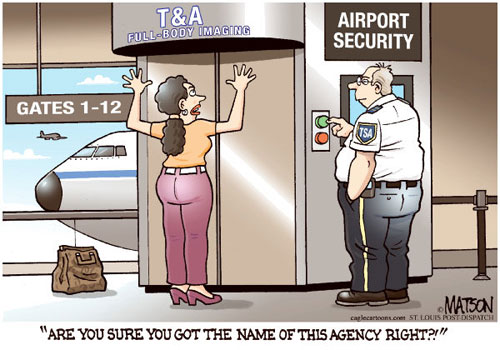
New airport screening technology lies there waiting
November 17, 2010 Attention, all air passengers who feel irked and even enraged at the notion that every time you fly, you now face a choice of being virtually stripped and anonymously ogled, or semi-privately fondled. It's a privacy price we all must pay in the name of homeland security. But a highly sensible high-tech solution exists that can protect your privacy and still protect our homeland.
TA Body Scanners
But not yet. This week, TV news has been gushing about passengers being upset because at 68 U.S. airports, the Department of Homeland Security now requires each passenger to stand in a refrigerator-sized machine that scans their bodies and produces X-ray type images of each passenger's body -- authentic bulges of avoirdupois and authentic outlines of his or her genitalia. The imaging machines also reproduce outlines of any concealed guns, knives, powdered or liquid explosives. And a security guard in a separate room views your body and, upon spotting a concealed item, requires a hand search. (Passengers who don't want images of their privates viewed can opt for a TSA pat down that includes touching crotches and chests.) But I began thinking that, since ours is now a world of photo-shopped, digitally altered snapshots, can't someone develop software solution -- one that reveals images of concealed items but not people's private parts? Just a generic body outline on which would appear anything a screened person was concealing? Turns out, some whiz has done just that. It is called Automatic Target Recognition (ATR), software for detecting contraband items on a person that can be used with the Advanced Imaging Technology. That's the X-ray that is now virtually strip-searching you because your airport doesn't use the ATR software. Unless you are reading this in the Netherlands. Last April, three Republican senators saw the technology demonstrated at Amsterdam's airport and came away impressed. So much so that Sens. Susan Collins, R-Me., Jon Kyl, R-Ariz., and Saxby Chambliss, R-Ga., wrote Homeland Security Secretary Janet Napolitano urging her department to consider using this "highly effective scan" that "identifies potentially threatening objects on a person and highlights with boxes on a featureless human body outline those areas of the individual that may require further inspection." Dutch officials began using this software technology after the attempted Christmas 2009 bombing of an airliner flying to Detroit by Umar Farouk Abdulmutallab. Dutch officials said there was a "high probability" the technology would have detected the explosives that reportedly were hidden in his underwear. But the ATR software has not been approved for use in the USA. Why? The huge news media operations of Homeland Security and the Transportation Security Administration were of no help in providing an explanation. So the most senior official we can quote on the record is a "Blogger Bob" who, in September, wrote in the TSA blog: "We're very interested in this next generation software, but ATR in its current form does not meet TSA's screening requirements, however, we're working closely with manufacturers to find software that does." No elaboration. So we must take it on trust -- from the same TSA web site that also informs us: "The image cannot be stored, transmitted or printed, and is deleted immediately once viewed." But that just isn't so. This summer, we learned that at a federal courthouse in Orlando, images from the same Advanced Imaging Technology device were not deleted immediately. In fact, U.S. Marshals kept and stored 35,000 images of persons who were screened before entering the courthouse. That was a fact the government withheld until being forced to reveal it under procedures of the Freedom of Information Act. Given that track record, how can we be sure the government is being truthful -- and is vigorously pursuing auto-targeting imaging software that can be our ultimate protector? When it comes to protecting our homeland and our privacy, we must demand from our government what it requires of us: Transparency.
Martin Schram writes political analysis for Scripps Howard News Service.
|
||
